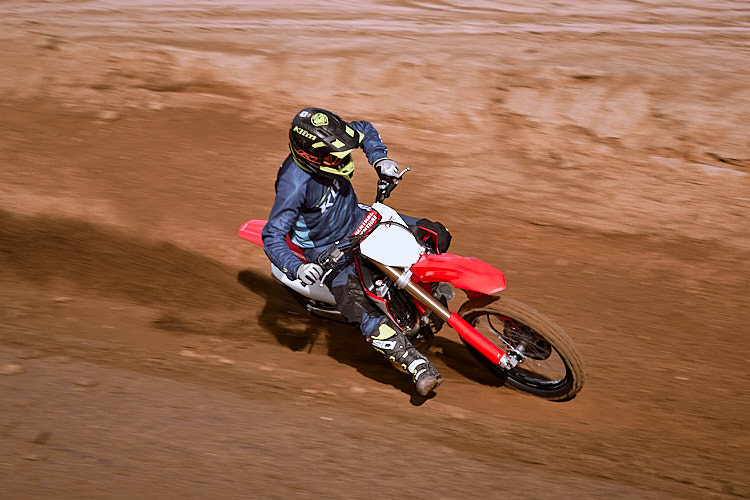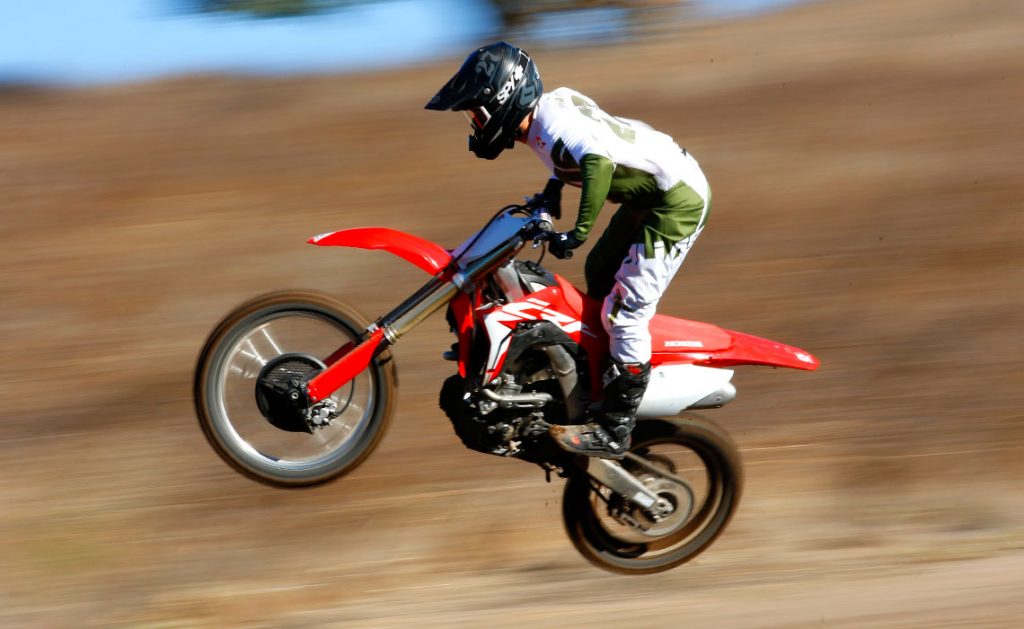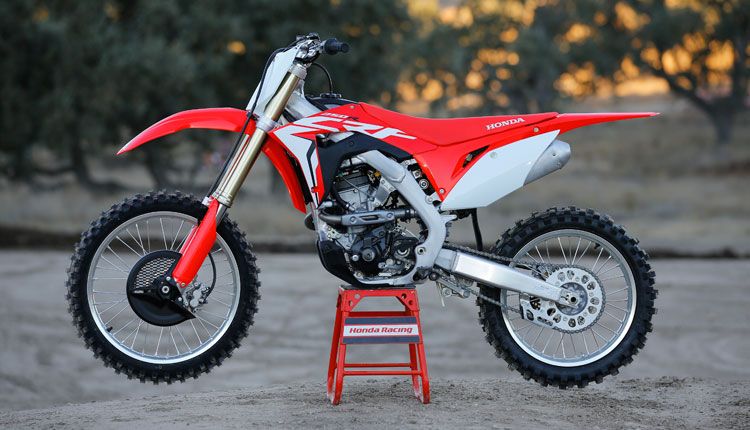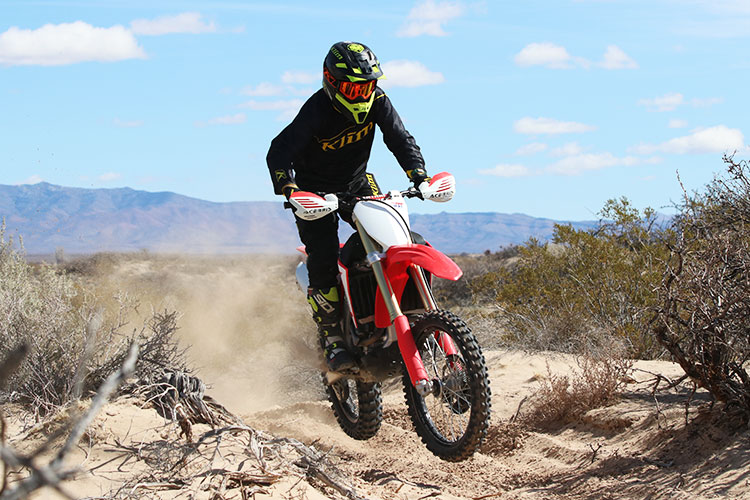
 Honda, like a few other manufacturers out there, is upping their model output with motocross bikes, off-road race bikes, trail oriented bikes, and street legal bikes. At first glance, each has a designated arena to ride/compete in with their signature R/RX/X/L in each model name. However, there’s a bit more to be dissected here and we’re specifically talking about the 250cc models. We’ll break down the differences so you can decide which one is best for you. Honda’s 250R motocrosser is the same bike used by the Geico Honda team in the stadiums and at all of the outdoor nationals, and the 250RX is what Preston Campbell and JCR Honda pilot in all of the Big6 GP’s and National Hare and Hounds.
Honda, like a few other manufacturers out there, is upping their model output with motocross bikes, off-road race bikes, trail oriented bikes, and street legal bikes. At first glance, each has a designated arena to ride/compete in with their signature R/RX/X/L in each model name. However, there’s a bit more to be dissected here and we’re specifically talking about the 250cc models. We’ll break down the differences so you can decide which one is best for you. Honda’s 250R motocrosser is the same bike used by the Geico Honda team in the stadiums and at all of the outdoor nationals, and the 250RX is what Preston Campbell and JCR Honda pilot in all of the Big6 GP’s and National Hare and Hounds.
Both the 250R and 250RX are similar and different in several different ways. Both Honda’s bikes are designed with more of an aggressive rider in mind with their high revving motors and equally stiff suspension/chassis components. Of course, the 250R leans even more on the aggressive side as it’s built for big jumps and deep ruts at the motocross track. The RX on the other hand is tamed down a bit to get a little bit of the comfort needed for off-road riding. After spending quite some time on both models, our findings suggest that the 250RX’s capabilities go far beyond the off-road racing world and enter the gates to the MX tracks as well as venture into trail-rideability. The bikes share frames and engines (including similar transmission ratios) so the are very close at heart.
As stated in our full test of the CRF250R, the bike takes us back to the days of 125cc two-strokes where sitting at the rev limiter will get you from point A to point B the quickest (though the bike is still much quicker and more capable than a 125cc two-stroke). As a result, aggressive riders do better with this motor characteristic using RPM to find every ounce of power needed to drop the lap times. Additionally, the suspension is on the stiffer side, to the point that we actually softened it up slightly for our lighter, yet quick test riders. While it doesn’t highlight an overly stiff chassis like it’s big brother has been known for, the chassis is compliant and balanced but works well with the stiffer suspension.  The 250RX is deemed the “off-road race bike” in Honda’s lineup, and therefore sees softer suspension and different ECU settings from the 250R. Receiving the comfort oriented settings (lighter damping inside the components) now transcends this bike into one more suited to novice/less experienced riders on the moto tracks. After spending a lot of time running through the maps on the RX, Map 2 (the “mellow” map) actually gives the motor a decent amount of torque and enough to pull you around in low RPMs, where a novice rider usually uses the engine. It’s much slower to build up RPMs and doesn’t produce as much power in the top end, but that’s what makes this more appealing to the less experienced crowd who rarely see the money-making part of the powerband. Of course, you can always put it back in the stock Map 1 or the aggressive Map 3 to enhance that top end pull, but knowing that there is some torque in the motor opens up the bike to a larger audience–it even surprised us as a capable trail riding bike. This power and RPM zone of the CRF250 motor’s character is rarely used on a track or when racing but the bike has a luggable appeal that is not talked about much from the racing impressions. (See 250F Off-Road Comparison) Overall it is pretty impressive what just ECU settings change on an engine.
The 250RX is deemed the “off-road race bike” in Honda’s lineup, and therefore sees softer suspension and different ECU settings from the 250R. Receiving the comfort oriented settings (lighter damping inside the components) now transcends this bike into one more suited to novice/less experienced riders on the moto tracks. After spending a lot of time running through the maps on the RX, Map 2 (the “mellow” map) actually gives the motor a decent amount of torque and enough to pull you around in low RPMs, where a novice rider usually uses the engine. It’s much slower to build up RPMs and doesn’t produce as much power in the top end, but that’s what makes this more appealing to the less experienced crowd who rarely see the money-making part of the powerband. Of course, you can always put it back in the stock Map 1 or the aggressive Map 3 to enhance that top end pull, but knowing that there is some torque in the motor opens up the bike to a larger audience–it even surprised us as a capable trail riding bike. This power and RPM zone of the CRF250 motor’s character is rarely used on a track or when racing but the bike has a luggable appeal that is not talked about much from the racing impressions. (See 250F Off-Road Comparison) Overall it is pretty impressive what just ECU settings change on an engine.
On the suspension side of things, the RX suspension is still on the stiff side, with its focus on faster, West coast style terrain to compliment the motor package. We even would feel comfortable racing the bike in stock trim at most western GP’s, whereas we wouldn’t say that about most other off-road bikes coming off of the showroom floor. On the moto tracks, our faster riders felt it’s on the softer side and could get in some trouble without being careful. It holds up well in the stroke, but not what most fast motocross riders prefer. When hitting faces and landing off of bigger jumps or getting aggressive through the larger braking bumps, it blows through the stroke and gets a little awkward trying to recover. However, slower riders will appreciate the suppleness and compliance that the RX suspenders boast. For those who stick to the vet tracks or who don’t charge hard into the deep ruts and big braking bumps, the RX components work very well with minor clicker adjustments and proper sag. Off-Road this setup allows the movement needed to get traction and have some versatility. It is not as soft as single-track woods riders would like but then those bikes will never see the track either. In conclusion, what Honda 250F suits who? There is the difference in gas tank size, the 18-inch rear wheel and a side stand added to the RX, common mods for a off-road conversion that Honda includes for much less than the price if modifying a motocross bike yourself. Internally the ECU and suspension settings typically take a higher level to tune, and Honda has done a great job here for the masses specific to each model. Aggressive riders tend to lean towards the flagship 250R for stiffer suspension settings and a more aggressive engine package/ECU settings, but we would be hard presses to reccomend the CRF250R over the CRF250RX for anything but pure motocross. However, the 250RX is ready to leave the trails in the dust and hit the MX tracks with novice level riders aboard. Overall, the RX is easier to ride with compliant suspension that absorb all of the little chop and chatter while the motor package is easier to keep in the meat of the power most of the time. They both start out as relatively the same bike, but some minor changes in production lead to a big change in the grand scheme of things and even lead to suiting different skilled riders on the same terrain.
In conclusion, what Honda 250F suits who? There is the difference in gas tank size, the 18-inch rear wheel and a side stand added to the RX, common mods for a off-road conversion that Honda includes for much less than the price if modifying a motocross bike yourself. Internally the ECU and suspension settings typically take a higher level to tune, and Honda has done a great job here for the masses specific to each model. Aggressive riders tend to lean towards the flagship 250R for stiffer suspension settings and a more aggressive engine package/ECU settings, but we would be hard presses to reccomend the CRF250R over the CRF250RX for anything but pure motocross. However, the 250RX is ready to leave the trails in the dust and hit the MX tracks with novice level riders aboard. Overall, the RX is easier to ride with compliant suspension that absorb all of the little chop and chatter while the motor package is easier to keep in the meat of the power most of the time. They both start out as relatively the same bike, but some minor changes in production lead to a big change in the grand scheme of things and even lead to suiting different skilled riders on the same terrain.
If you want to know more about these bikes check out: https://powersports.honda.com/off-road/competition/crf250r or https://powersports.honda.com/off-road/competition/crf250rx
And you can always comment below, check out our Dirt Bike Test YouTube videos, follow us @dirtbiketest on all the channels and tell a friend.

Support DBT, Shop and search for products through the link below:


